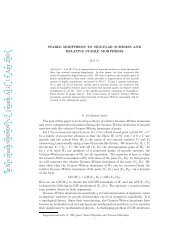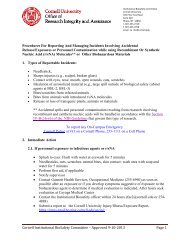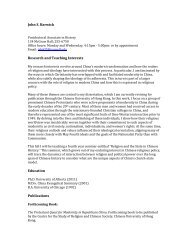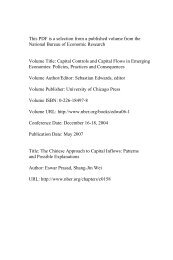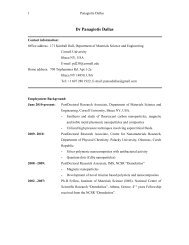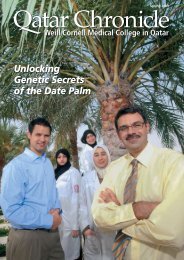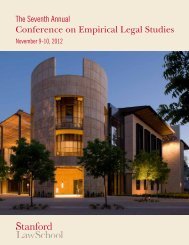Simultaneous Mode and Wavelength Division Multiplexing On-Chip
Simultaneous Mode and Wavelength Division Multiplexing On-Chip
Simultaneous Mode and Wavelength Division Multiplexing On-Chip
Create successful ePaper yourself
Turn your PDF publications into a flip-book with our unique Google optimized e-Paper software.
LE CUCINE DELLA VITA..
output ports, we can quantify the amount of crosstalk resulting from the spatial modemultiplexing <strong>and</strong> demultiplexing. Figure 2c shows the transmission spectrum at output port 1(see port definitions in Fig. 2a) from each input. The insertion loss of this port is 13 dB <strong>and</strong> theoptical crosstalk (defined as the ratio of desired signal power to the sum of the interferingchannels’ power) is as low as -30 dB. The insertion loss of port 2 is 16 dB <strong>and</strong> the opticalcrosstalk is -18 dB (Fig. 2d). The insertion loss of port 3 is 26 dB <strong>and</strong> crosstalk is -13 dB (Fig. 2e).The main contribution to the insertion loss is the aggregate 10-dB fiber-to-chip coupling loss.The rest of the insertion loss is attributed to the waveguide propagation loss <strong>and</strong> ring intrinsicloss. By ensuring critical coupling between the waveguides <strong>and</strong> rings, achievable on-chip lossesof this device are expected to total around 1.5 dB. The higher insertion loss in port 3 comparedto the other 2 ports is due to a suboptimal ring coupling gap. The crosstalk from the unwantedinput signals can be minimized by optimizing the coupling length between the ring <strong>and</strong> themultimode waveguide to reduce coupling of undesired modes (Supplementary Fig. 1). Weexpect the crosstalk at output port 3 of the current device to be less than -16 dB for anoptimized coupling length of 6 µm (larger than the fabricated one with only 5 µm) (see Fig. 2f).The crosstalk can be further reduced by introducing weaker coupling at the ring-multimodewaveguide coupling region (by having a larger coupling gap) to lower the maximum coupling ofthe undesired modes at the expense of longer coupling length to maintain the critical couplingcondition (Supplementary Fig. 2).5
illustrated in Fig. 3a. In order to measure these power penalties the laser channel at 1563 nm ismodulated with PRBS 2 31 -1 on-off-keyed (OOK) data by an amplitude modulator <strong>and</strong> thenfurther phase-imprinted with a swept-frequency sinusoid in order to enable bit-error-rate (BER)measurements on channels which experience coherent crosstalk (further information providedin the Methods section). The data signal is then amplified, split evenly between the 3 inputports of the on-chip mode multiplexer, <strong>and</strong> simultaneously injected in quasi-TE polarization tothe multiplexer ports. The varying fiber spans leading to the device ensure that the data isdecorrelated between the ports (see methods section). The demultiplexed signals arerecovered one at a time for inspection on a DCA <strong>and</strong> BER evaluation. Error free transmission(BER < 10 -12 ) <strong>and</strong> open eye diagrams (Fig. 3b,c) are observed for all output ports. To account forfabrication imperfections, we improve the performance of port 3 at the expense of increasedcrosstalk <strong>and</strong> spectral filtering penalties on port 2 by wavelength detuning the TE 1 multiplexerring. This enables device operation with an overall balanced power penalty (measured at a BERof 10 -9 ) of 1.9 dB on ports 2 <strong>and</strong> 3 <strong>and</strong> 0.5 dB on port 1. In order to verify that intra-channelcrosstalk is indeed the main mechanism of signal degradation 31 , we also inspect the channelperformance with only one input port injected at a time. We observe that transmissionpenalties result in 0.1 dB penalties on ports 1 <strong>and</strong> 2 <strong>and</strong> 0.8 dB on port 3 (with the higherpenalty on port 3 resulting from the higher insertion loss through this port which leads to alarger OSNR degradation at the post-chip EDFA). Therefore we conclude that crosstalk is themain contributing factor to signal degradation in this device. The penalties are measuredrelative to a back-to-back (B2B) reference case which is defined <strong>and</strong> measured by replacing the7
We measure a low (< 1.4 dB) power penalty for joint MDM-WDM operation bylaunching three different 10-Gb/s wavelength channels spanning the full C-b<strong>and</strong> into two inputports of the multiplexer (ports 1 <strong>and</strong> 2). A modified setup (depicted in Fig. 4a) is used tocorrectly decorrelate the wavelength channels (see methods section) <strong>and</strong> more polarizers areincluded in it to ensure that all the wavelength channels are launched on chip at the quasi-TEpolarization with equal power. We set the wavelength channels to span the full C-b<strong>and</strong> (limitedby the EDFA gain b<strong>and</strong>) <strong>and</strong> the microrings are tuned on-resonance to maximize powertransmission at 1547 nm. The power penalties for both ports vary between 0.6 <strong>and</strong> 1.4 dB forall three wavelength channels (Fig. 4b) with performance variation attributed to slightly varyinglevels of crosstalk for the different wavelength channels. Error free transmission (BER < 10 -12 )<strong>and</strong> open eye diagrams (Fig. 4c) are observed for all the three channels at the two output ports.These results show that only a minimal penalty is added by extending the device operation tosupport WDM concurrently with the MDM.9
mentioned dimensions can potentially support an aggregate data rate up to 4.35 Tb/s with 5spatial modes <strong>and</strong> 87 WDM channels.MethodsDevice design <strong>and</strong> fabrication – We fabricate the reconfigurable MDM-WDM silicon microringresonators on a 250 nm SOI wafer with 3 µm of buried oxide using st<strong>and</strong>ard CMOS fabricationprocesses. We patterned the waveguides using e-beam lithography with the dimensions asfollowed: the input/output ports <strong>and</strong> the microring are 450 nm wide; the TE 0 , TE 1 , <strong>and</strong> TE 2(de)multiplexers have a width of 450 nm, 930 nm, <strong>and</strong> 1.41 μm wide; <strong>and</strong> each (de)multiplexeris linked by an adiabatic taper of 80 μm long. All the microrings have a radius of 10 μm <strong>and</strong> acoupling length of 5 μm. The separation gap between the microrings <strong>and</strong> all the inputwaveguides is 240 nm while the separation gap between the microrings <strong>and</strong> TE 0 , TE 1 , <strong>and</strong> TE 2(de)multiplexers are 240 nm, 200 nm <strong>and</strong> 200 nm respectively. The silicon waveguides are thenetched, followed by the e-beam resist being stripped <strong>and</strong> the etched structures are clad with 1µm thick silicon oxide layer using plasma enhanced chemical vapor deposition to confine theoptical mode. 300 nm of NiCr are next evaporated on the microrings resonators above thecladding to create the 1 µm wide heaters. Finally, 500 nm of gold (Au) are evaporated to definethe electrical wires <strong>and</strong> contact pads using a lift-off process. The final fabricated device isillustrated in Fig. 2a. The footprint of this device is 0.11 mm 2 excluding the electrical wires.Optical modes imaging at the cross-section of the multimode waveguide – We fabricate a testdevice that only has the mode multiplexer section (TE 0 , TE 1 , <strong>and</strong> TE 2 ) <strong>and</strong> is terminated with the1.41-μm wide multimode bus waveguide. We couple a 1547 nm laser (on-resonance of each11
Grant No. 1143893. This work was supported in part by the NSF through CIAN ERC under GrantEEC-0812072 <strong>and</strong> was performed in part at the Cornell NanoScale Facility, a member of theNational Nanotechnology Infrastructure Network, which is supported by the NSF. The authorsalso acknowledge support from the NSF <strong>and</strong> Semiconductor Research Corporation under grantECCS-0903406 SRC Task 2001. Lian-Wee Luo acknowledges a fellowship from Agency of Science,Technology <strong>and</strong> Research (A*STAR), Singapore.Author ContributionL.W.L <strong>and</strong> N.O. contributed equally to this work. L.W.L. designed, <strong>and</strong> fabricated the devicewith the assistance of L.H.G. in the simulations. L.W.L, N.O. <strong>and</strong> C.C conducted the experimentstogether. L.W.L, N.O., K.B. <strong>and</strong> M.L. discussed the results <strong>and</strong> implications. L.W.L, N.O. <strong>and</strong> M.L.contributed to the writing of this paper.Competing financial interestsThe authors declare no competing financial interests.References1 Nagarajan, R. et al. Large-scale photonic integrated circuits. Selected Topics in QuantumElectronics, IEEE Journal of 11, 50-65 (2005).2 Jalali, B. & Fathpour, S. Silicon Photonics. Lightwave Technology, Journal of 24, 4600-4615(2006).3 Richardson, D. J., Fini, J. M. & Nelson, L. E. Space-division multiplexing in optical fibres. NatPhoton 7, 354-362 (2013).14
4 Sakaguchi, J. et al. 109-Tb/s (7x97x172-Gb/s SDM/WDM/PDM) QPSK transmission through 16.8-km homogeneous multi-core fiber, in Optical Fiber Communication Conference (Optical Societyof America) (2011).5 Feuer, M. D. et al. ROADM System for Space <strong>Division</strong> <strong>Multiplexing</strong> with Spatial Superchannels, inOptical Fiber Communication Conference (Optical Society of America) (2013).6 Sakaguchi, J. et al. 19-core fiber transmission of 19x100x172-Gb/s SDM-WDM-PDM-QPSK signalsat 305Tb/s, in Optical Fiber Communication Conference (Optical Society of America) (2012).7 Takara, H. et al. 1.01-Pb/s (12 SDM/222 WDM/456 Gb/s) Crosstalk-managed Transmission with91.4-b/s/Hz Aggregate Spectral Efficiency, in European Conference <strong>and</strong> Exhibition on OpticalCommunication (Optical Society of America) (2012).8 Qian, D. et al. 1.05Pb/s Transmission with 109b/s/Hz Spectral Efficiency using Hybrid Single- <strong>and</strong>Few-<strong>Mode</strong> Cores, in Frontiers in Optics (Optical Society of America) (2012).9 R<strong>and</strong>el, S. et al. 6×56-Gb/s mode-division multiplexed transmission over 33-km few-mode fiberenabled by 6×6 MIMO equalization. Opt. Express 19, 16697-16707 (2011).10 Hanzawa, N. et al. Demonstration of mode-division multiplexing transmission over 10 km twomodefiber with mode coupler, in Optical Fiber Communication Conference <strong>and</strong> Exposition(OFC/NFOEC) (2011).11 Ryf, R. et al. <strong>Mode</strong>-<strong>Division</strong> <strong>Multiplexing</strong> Over 96 km of Few-<strong>Mode</strong> Fiber Using Coherent 6 × 6MIMO Processing. J. Lightwave Technol. 30, 521-531 (2012).12 Salsi, M. et al. <strong>Mode</strong>-<strong>Division</strong> <strong>Multiplexing</strong> of 2 x 100 Gb/s Channels Using an LCOS-Based SpatialModulator. Lightwave Technology, Journal of 30, 618-623 (2012).13 Al Amin, A. et al. Dual-LP11 mode 4x4 MIMO-OFDM transmission over a two-mode fiber. Opt.Express 19, 16672-16679 (2011).15
14 Bai, N. et al. <strong>Mode</strong>-division multiplexed transmission with inline few-mode fiber amplifier. Opt.Express 20, 2668-2680 (2012).15 Ryf, R. et al. 32-bit/s/Hz Spectral Efficiency WDM Transmission over 177-km Few-<strong>Mode</strong> Fiber, inOptical Fiber Communication Conference (Optical Society of America) (2013).16 Ip, E. et al. 146λx6x19-Gbaud <strong>Wavelength</strong>- <strong>and</strong> <strong>Mode</strong>-<strong>Division</strong> Multiplexed Transmission over10x50-km Spans of Few-<strong>Mode</strong> Fiber with a Gain-Equalized Few-<strong>Mode</strong> EDFA, in Optical FiberCommunication Conference (Optical Society of America) (2013).17 Li, A., Al Amin, A., Chen, X. & Shieh, W. Transmission of 107-Gb/s mode <strong>and</strong> polarizationmultiplexed CO-OFDM signal over a two-mode fiber. Opt. Express 19, 8808-8814 (2011).18 Bagheri, S. & Green, W. Silicon-on-insulator mode-selective add-drop unit for on-chip modedivisionmultiplexing, in Group IV Photonics, 2009. GFP '09. 6th IEEE International Conference on(2009).19 Yingyan, H., Guoyang, X. & Seng-Tiong, H. An Ultracompact Optical <strong>Mode</strong> Order Converter.Photonics Technology Letters, IEEE 18, 2281-2283 (2006).20 Kawaguchi, Y. & Tsutsumi, K. <strong>Mode</strong> multiplexing <strong>and</strong> demultiplexing devices using multimodeinterference couplers. Electron Lett 38, 1701-1702 (2002).21 Uematsu, T., Ishizaka, Y., Kawaguchi, Y., Saitoh, K. & Koshiba, M. Design of a Compact Two-<strong>Mode</strong>Multi/Demultiplexer Consisting of Multimode Interference Waveguides <strong>and</strong> a <strong>Wavelength</strong>-Insensitive Phase Shifter for <strong>Mode</strong>-<strong>Division</strong> <strong>Multiplexing</strong> Transmission. Lightwave Technology,Journal of 30, 2421-2426 (2012).22 Leuthold, J., Hess, R., Eckner, J., Besse, P. A. & Melchior, H. Spatial mode filters realized withmultimode interference couplers. Opt. Lett. 21, 836-838 (1996).23 Greenberg, M. & Orenstein, M. Multimode add-drop multiplexing by adiabatic linearly taperedcoupling. Opt. Express 13, 9381-9387 (2005).16
24 Ding, Y. et al. <strong>On</strong>-chip two-mode division multiplexing using tapered directional coupler-basedmode multiplexer <strong>and</strong> demultiplexer. Opt. Express 21, 10376-10382 (2013).25 Dai, D., Wang, J. & Shi, Y. Silicon mode (de)multiplexer enabling high capacity photonicnetworks-on-chip with a single-wavelength-carrier light. Opt. Lett. 38, 1422-1424 (2013).26 Lee, B.-T. & Shin, S.-Y. <strong>Mode</strong>-order converter in a multimode waveguide. Opt. Lett. 28, 1660-1662 (2003).27 Love, J. D. & Riesen, N. Single-, Few-, <strong>and</strong> Multimode Y-Junctions. Lightwave Technology, Journalof 30, 304-309 (2012).28 Driscoll, J. B. et al. Asymmetric Y junctions in silicon waveguides for on-chip mode-divisionmultiplexing. Opt. Lett. 38, 1854-1856 (2013).29 Yariv, A. Universal relations for coupling of optical power between microresonators <strong>and</strong>dielectric waveguides. Electron Lett 36, 321-322 (2000).30 Sherwood-Droz, N. et al. Optical 4x4 hitless slicon router for optical networks-on-chip (NoC).Opt. Express 16, 15915-15922 (2008).31 Ramaswami, R., Sivarajan, K. & Sasaki, G. Optical Networks: A Practical Perspective. (ElsevierScience, 2009).32 Doany, F. E. et al. Multichannel High-B<strong>and</strong>width Coupling of Ultradense Silicon PhotonicWaveguide Array to St<strong>and</strong>ard-Pitch Fiber Array. Lightwave Technology, Journal of 29, 475-482(2011).17
Supplementary informationCoupled-mode theory for two weakly coupled optical modes relates the complexamplitudes of the modes, a 1 <strong>and</strong> a 2 through a set of differential equations 1 :da1jβ1a1κ12a2dz (1)da2jβ2a2 κ21a1dz . (2)The solutions to this equation set, assuming the waves a 1 (0) <strong>and</strong> a 2 (0) are launched at z= 0, are given by: β2 β 1κ12a1( z) a1( 0) cosβ0 z j sin β0z a2( 0)sinβ0z e 2β0 β0j ( β1β 2)/2 z(3)κ 21β1 β 2a2( z) a1( 0)sin β0z a2( 0) cosβ0 z j sinβ0z eβ0 2β0j ( β1β 2)/2 z(4)whereββ β 2 1 20 12 212κ κ. (5)If the initial waves a 1 (0) = 1 <strong>and</strong> a 2 (0) = 0 are assumed, then the coupling from a 1 to a 2 isκ21given by sinβz0β0. Below we take a look at the example of the 1.41-μm wide multimodewaveguide <strong>and</strong> investigate the coupling strength between the phase-matched TE 2 spatial mode18
<strong>and</strong> the TE 0 mode of 450-nm wide waveguide at λ = 1.55 μm (see Fig. 1a). The coupling gapbetween the two different waveguides is fixed at 200 nm. To achieve 100% power transfer fromthe 450-nm waveguide (TE 0 ) to the 1.41-μm waveguide (TE 2 ) using a directional coupler <strong>and</strong>vice versa, the coupling length (L coupling ) is required to be 42 μm (see Fig. 1c). To realize acompact device, we use microring resonators instead of a directional coupler. Weak coupling(achievable with a short coupling length) is sufficient to transfer nearly all the power from theinput waveguide of the microring to the multimode waveguide (typically termed criticalcoupling) 2 (see Fig. 1b). We also calculate the coupling strength of the unwanted modes (TE 1 ,TE 0 ) which determines the crosstalk of the device. We observe that there is coupling to theundesired modes (TE 1 , TE 0 ), however the coupling is weak due to the phase mismatch betweenthese modes. The maximum coupling strength of TE 1 mode is 0.057. The optimum operatingregime for low crosstalk is at L coupling ≈ 6 μm where the coupling to the undesired modes (TE 1 ,TE 0 ) is minimized.Figure 1 Coupling strength of different spatial modes (TE 2 , TE 1 , TE 0 ) of a 1.41-μm widewaveguide to the TE 0 mode of a 450-nm wide silicon waveguide with a coupling gap of 200 nm.19
The maximum coupling strength of TE 1 mode is 0.037. The optimum operating regime for lowcrosstalkregime is at L coupling ≈ 11 μm.Reference1 Haus, H. A. Waves <strong>and</strong> fields in optoelectronics. (Prentice-Hall, 1984).2 Yariv, A. Universal relations for coupling of optical power between microresonators <strong>and</strong>dielectric waveguides. Electron Lett 36, 321-322 (2000).21




